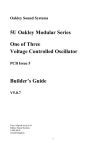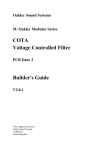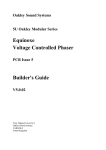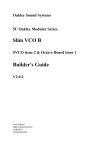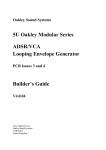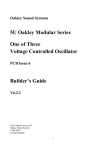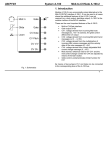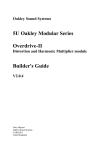Download Builder`s Guide - Oakley Sound Systems
Transcript
Oakley Sound Systems 5U Oakley Modular Series VC-LFO Low Frequency Oscillator PCB Issue 3 Builder’s Guide V3.0.00 Tony Allgood B.Eng PGCE Oakley Sound Systems CARLISLE United Kingdom The suggested panel layout of the issue 3 VC-LFO module. This is different to the older issue 1 VC-LFO panel in that we lose a switch and gain an additional pot. Introduction This is the Project Builder's Guide for the issue 3 VC-LFO 5U module from Oakley Sound. Please note that the issue 3 PCB is marked incorrectly as issue 2. The way to tell them apart is that true issue 3 boards are fitted with a HFT trimmer in top right hand corner. This document contains a basic introduction to the board, a description of the schematic, a full parts list for the components needed to populate the boards, and a list of the various interconnections. For the User Manual, which contains an overview of the operation of the unit, the history of the various board issues, and all the calibration procedures, please visit the main project webpage at: http://www.oakleysound.com/lfo.htm For general information regarding where to get parts and suggested part numbers please see our useful Parts Guide at the project webpage or http://www.oakleysound.com/parts.pdf. For general information on how to build our modules, including circuit board population, mounting front panel components and making up board interconnects please see our generic Construction Guide at the project webpage or http://www.oakleysound.com/construct.pdf. The issue 3 VC-LFO PCB The issue 3 PCB mounted behind a natural finish panel. Note the use of the optional Sock8 socket board to facilitate the wiring up of all those sockets. I have provided space for the three main control pots on the PCB. If you use the specified 16mm Alpha pots and matching brackets, the PCB can be held firmly to the panel without any additional mounting procedures. The pot spacing is 1.625” and is the same as the vertical spacing on the MOTM modular synthesiser and most of our other modules. The design requires plus and minus 15V supplies. The power supply should be adequately regulated. The current consumption is about 40mA for each rail. Power is routed onto the PCB by a four way 0.156” MTA156 type connector or the special five way Synthesizers.com MTA100 header. You could, of course, wire up the board by soldering on wires directly. The four pins are +15V, ground, earth/panel ground, -15V. The earth/panel connection allows you to connect the metal front panel to the power supply’s ground without it sharing the modules’ ground line. More about this later. The PCB has four mounting holes for M3 bolts, one near each corner. These are not required if you are using the two 16mm pot brackets. The board size is 104mm (high) x 104mm (deep). The board has been laid out to accept connection to our Sock8 socket board. This small board speeds up the wiring of the eight sockets and reduces the chances of mistakes. Circuit Description The VC-LFO circuit consists of several sections spread over two pages; the CV summer and exponential convertor (page 1), the VC-LFO core (page 2), sine shaper (page 1), sawtooth shaper page 2), LED driver (page 1) and power supplies (page 2). Looking at the bottom of page 2 of the schematic is the power supply section. This includes the power supply inlets, PWR and PSU, and the power supply filtering components. U1 provides a stable +5V supply for the DG403's digital input circuitry. The original VC-LFO boards had no such supply and the DG403 was driven from +15V only. However, when Vishay bought out Siliconix, the original manufacturer of the device, some of the specifications changed, in particular the lower threshold voltage for the analogue switch control. This meant that the Vishay specimens of DG403 when used in the VC-LFO did not correctly respond to sync pulses. Vishay DG403 devices required a higher voltage than what provided by my sync input circuit and +5V gate signals were not able to reset the LFO core reliably. By driving the logic part of the DG403 from a 5V supply this insensitivity to input levels is removed. Two grounds are provided, one for the circuit itself, and one for the earthing of the jack sockets on the front panel. There are eight ICs on this PCB, and each requires power, and the mass of capacitors nearby are power supply decoupling. Both these sections of the circuit are separated from the main circuit to avoid cluttering up the main parts of the diagram. On the PCB itself those decoupling capacitors are actually as close the action as they can be. The closer those caps are to their parent IC, the more effective they become. They are like little reservoirs of charge to provide the current to the IC when it needs it. And they can usually supply it faster than the power supply itself, if only for a very short period of time. The VC-LFO’s pitch is determined by a variety of sources. Two CV inputs, one pot and a switch on the front panel, and a trimmer to set initial frequency. U2a (pins 1, 2, 3) is built as a voltage summer. It takes the voltages from the six sources and adds them together. The gain of the summer is set by the input resistors and R7. The output of the CV summer is then fed to an inverting amplifier of adjustable gain via the V/OCT trimmer. The V/OCT trimmer is adjusted to give a rise of one octave in output frequency when the KEY-CV input voltage goes up by 1V. The output of this amplifier is then fed to the exponential convertor via R47 and TC. The exponential convertor is based around on half of U3b (pins 5, 6, 7) and the matched PNP pair of U7. Its output is a current that is proportional to the exponent of the voltage applied at the base of the left hand transistor of U7. The circuit gives the VC-LFO a sensitivity of roughly +18mV/octave, so R47 and TC reduce the output of the CV summer to this level. However, it is worth noting that TC is a temperature sensitive resistor. The resistance of TC will go up with temperature at a rate of 0.35% for every degree Celsius. This should counteract the temperature effects produced by the semiconductor junctions in U6. To get the best temperature stability TC is mounted right on top of U7. This way the temperature of the two devices should be the same. It is possible to get an exponential response from a single transistor, but that has problems as Vbe, the junction voltage, changes with ambient temperature. The ‘temp co’ resistor cannot compensate for this change in the transistor’s operating current. So the now classic circuit with two perfectly matched transistors and an op-amp, U7 and U3b, is used. Changes in the Vbe for one half of the transistor pair are mirrored in the other. The op-amp then matches the current in the first transistor with the same current in the other one. So the collector current in the first transistor will effectively control the collector current in the second. And it is the current drawn by the second transistor that controls the frequency of the VCO. The output of the exponential convertor is a current. It is this current that controls the core of the oscillator. Contrary to most people’s ideas, the core of a VCO is typically a linear CCO. That is a current controlled oscillator. A doubling of current to the CCO will produce a doubling of output frequency. The core of this VC-LFO creates a triangle wave from which all the other waveshapes are created. This is different to the standard sawtooth core design used by the Oakley VCO. A KRL +3500ppm/K positive temperature coefficient resistor bent over the top of the transistor array U7. Note the preforming of the device's leads to make it fit snugly into place. This is a more expensive and bigger PTC resistor than the recommended one and is probably a little over the top for a VC-LFO. The smaller +3000ppm/K device is quite adequate. You could also use some heat conducting paste for better thermal conductivity between the two devices. The core itself is built from two main parts. An integrator and a schmitt trigger. The output from each feeds into the next, and then right round again. We will start by looking at each bit in turn. The heart of the VC-LFO core is the LM13700 IC, U8. This is a dual OTA (operational transconductance amplifier). The OTA is different in several respects to a usual op-amp. Firstly, its output is a current, not a voltage. Secondly, its gain is controlled by a current injected into the Iabc pin. ‘I’ is for current, ‘abc’ stands for amplifier bias current. The bigger this current the higher the gain of the OTA. However, the current into the Iabc pin of the 13700 must not exceed 2mA otherwise damage will result to the OTA. R42 limits the Iabc to a safe value. Together with op-amp U9a (pins 1, 2, 3), U8a forms the non-inverting integrator whose time constant is controlled by the Iabc. Any negative voltage applied to pin 4 of U8, will cause the voltage to fall at the output of the op-amp. The speed at which the voltage falls is controlled by C12 and the Iabc current. If the applied voltage to pin is positive the op-amp’s output will rise. It is the integrator’s output that will be used as the source for the triangle output. The DG403 is configured as four electronically controlled switches. They are arranged in pairs, so that when one switch of the pair is closed the other is open. When a switch is closed the signal can pass through pretty much unaffected. One channel of the DG403 (pins 5 & 6) is wired so that the output of the integrator passes straight to the schmitt trigger. This connection can be broken when the sync pulse is applied, but more about this later. The schmitt trigger is a simple circuit block based around the other half of the OTA. It is configured as an inverting schmitt trigger and its output, at pin 12 is either high at +1.8V, or low at -1.8V. If the output of the Schmitt is initially low, it requires an input of less than -1.8V at the output of the integrator to make it go high. Conversely, the integrator will need to produce an output of +1.8V to make the Schmitt go low again. To make any oscillator you normally require an output to be fed back into the input. In the VCLFO, the non inverting integrator is fed by the output of the inverting schmitt trigger. Thus, a ‘high’ at the output of the schmitt causes the integrator to rise. When the integrator’s output reaches a certain point, the schmitt switches state and the integrator’s output falls. The schmitt trigger changes state once again, and the process repeats itself.... C12 effectively controls the overall range of frequencies produced by the VC-LFO. You may want to try different values for this capacitor. Lower values of C12 will give you a faster oscillator. Indeed, the VC-LFO will make a very nice audio only VCO if you make C12 1nF. The two back to back zener diodes, D3 and D4, strapped across the input of U8b prevent the input voltage at pin 13 exceeding the maximum allowed by the LM13700. In ordinary operation this will never happen, but in some cases, if your power supply comes up too slowly, the integrator output can get too positive (or too negative) for the briefest of moments and the schmitt trigger 'latches up'. This nasty bit of behaviour is when the input devices within the LM13700 get turned on too hard and draw excessive current through the input pins. If latch up has occurred then only by removing the input signal to pin 13 (with an active sync pulse) or by powering down the module can the input be unlatched. The two diodes prevent any such latch up occurring in first place no matter what the power supply does on power up. A tri-colour LED is used to give the user an idea of LFO speed. It will change colour depending on whether the integrator is charging or discharging. It is driven from two transistors, Q1 and Q2, directly from the square wave output. The triangle output of the module needs to be increased in level before sending out to the front panel. The raw triangle signal is taken from the integrator’s output and passed into an inverting amplifier, built around U9b, to increase the +/-1.8V signal to the required +/-5V output level. The square wave output is derived from the output of the schmitt trigger. It is then fed to an non inverting amplifier, built around U5a, to give use the standard +/-5V output. When a pulse or gate appears at the ‘sync’ input, the pulse or gate is shaped by C3, R6 and D2 to give a short positive spike. This controls the two channels of the DG403. Normally, as I mentioned earlier, this part of the DG403 allows the integrator output to pass straight to the Schmitt trigger. However, when a spike is present at pin 10 of the DG403, two things happen. Firstly, the integrator output is cut off from the schmitt trigger by the opening of the FET switch between pins 5 and 6. R20 will then force the schmitt trigger’s input low and the Schmitt’s output will be set low. Secondly, the integrator capacitor will be shorted out, by the closing of the FET switch between pins 8 and 9. This will set the integrator’s output at zero volts. When the ‘sync’ spike fades away, the integrator will start to ramp positive due to the positive voltage from the schmitt trigger. If we did not force the Schmitt low then the integrator would have randomly ramped either up or down. The sawtooth and ramp shaping circuitry looks complex, but it can be broken down quite simply. U5b acts as a dual mode circuit, it is either a buffer or an inverter. It acts on the amplified triangle wave output. What mode it is in is determined by the switch within one of the channels of the DG403. When the internal switch is closed, U4 acts as a inverting amplifier with gain -1. Pin 5 is effectively tied to ground by the action of the switch. But when the switch is opened, pin 5 is attached to the triangle wave input via R23 and R26. These two resistors form a parallel combination of exactly 11K. U4 now acts as a unity gain buffer, ie. an amplifier with a gain of +1. The switch in U3 is controlled by the square wave output. That means when the integrator is discharging it is switched off and U4 is in ‘buffer’ mode. When the integrator is charging, U4 is in inverting mode. The triangle input is then switched rapidly from being buffered and unaffected, to being inverted. This chops the regular up and down waveform of the triangle into two sections, one as before, the other tipped upside down. This creates two sections of ramping up, ie. a ramp waveform but of twice the original frequency. By adding a square wave signal to this ramp signal in the correct proportions we get another ramp waveform but at the original frequency. U10b (pins 5, 6, 7) is a standard inverting summing circuit. It combines the square wave and twice frequency ramp signal and inverts the sum to get a sawtooth. This is our sawtooth waveform and this is goes through R37 to connect to the output socket. A ramp waveform is simply created by inverting the sawtooth output with an inverting op-amp based around U10a (pins 1, 2, 3), shown on page one. The sine wave shaper circuit, also shown on page one of the schematics, acts upon the raw triangle wave output of the integrator. The rounded peaks of the sine wave are created by deliberately overdriving the inputs of a differential amplifier built around the NPN pair in U7 and recovery amplifier U2a. The non linearities of the input stage being utilised to squash the top and bottom peaks of the triangle wave input. The gain of the shaper is fixed partly by R57. SHP adjusts the amount of overdrive. R58 and R59 provide a special feedback path, called emitter degeneration, within the input circuit. This causes the input devices to be tickled even further into overdrive at the critical peaks of the output waveform. The trimmer, OFF, provides compensation for any small imbalance in the NPN transistors. Any differences in base-emitter voltages between the two transistors will make them soft clip asymmetrically. By adding a small voltage of the opposite polarity to one of the input pins, we can cancel the effects of the offset. The sine wave created by this process does not give us a perfect textbook example of a sine wave. However, the wave is very low in harmonics and has a nice rounded shape. This makes is perfect for modulation purposes and sounds good too. Issue 3 VC-LFO Parts List For general information regarding where to get parts and suggested part numbers please see our useful Parts Guide at the project webpage or http://www.oakleysound.com/parts.pdf. The components are grouped into values, the order of the component names is of no particular consequence. A quick note on European part descriptions. R is shorthand for ohm. K is shorthand for kilo-ohm. R is shorthand for ohm. So 22R is 22 ohm, 1K5 is 1,500 ohms or 1.5 kilohms. For capacitors: 1uF = one microfarad = 1000nF = one thousand nanofarad. To prevent loss of the small ‘.’ as the decimal point, a convention of inserting the unit in its place is used. eg. 4R7 is a 4.7 ohm, 4K7 is a 4700 ohm resistor, 6n8 is a 6.8 nF capacitor. Resistors All resistors should be 0.25W 1% metal film (MF) types unless stated. 22R 390R 1K 2K 3K 3K3 4K7 5K6 10K 18K 20K 22K 30K 33K 39K 47K 51K 68K 100K 180K 220K 470K 680K 1M R1 R45, R52 R38, R37, R36, R34, R40, R2, R3 R30 R41 R43 R57 R29, R39 R33, R42, R5, R18, R35 R53 R58, R59 R23, R27, R4, R26, R24 R21 R15, R50, R32 R46, R47, R44, R25, R28 R16 R22, R54, R49, R11, R48 R7, R55 R20, R6, R19, R14, R12 R9 R13 R10, R17, R51, R56 R8 R31 1K +3000ppm/K PTC TC* * This is fitted across U7 and soldered only after U7 has been placed. See picture earlier on in this document. Capacitors 100nF multilayer axial ceramic 150pF ceramic low-K 2.5mm 33pF ceramic low-K 2.5mm 470pF ceramic low-K 2.5mm 4n7, 63V polyester film 2u2, 63V electrolytic 22uF, 25V electrolytic C4, C10, C6, C5, C13, C14, C7 C3 C8, C11 C9 C12 C1, C15, C16 C2 Semiconductors 1N4148 signal diode BAT42 Schottky diode 2V7 500mW zener diode 6V2 500mW zener diode BC550 NPN transistor Red/Green tri-colour LED D1, D5, D7 D6 D3, D4 D2 Q1, Q2 LED1 - Mounted off board via flying wires. Integrated Circuits 78L05 +5V 100mA regulator LM13700N dual OTA TL072CN dual op-amp DG403 dual analogue switch THAT340 matched NPN/PNP pair U1 U8 U10, U6, U3, U5, U2, U9 U4 U7 IC sockets can also be used. You need two 16 pin DIL sockets, one 14 pin DIL socket, and six 8 pin DIL sockets. Pots All pots 16mm Alpha or equivalent. 47K or 50K linear Alpha pot brackets FINE, CV1-DEPTH, COARSE 2 off Trimmers 500R 6mm horizontal 2K 6mm horizontal 50K 6mm horizontal 100K 6mm horizontal 100K multiturn 20K multiturn SHP HFT STEP OFF TUNE V/OCT Miscellaneous Leaded axial ferrite beads L1, L2 MTA156 4 way header MTA100 6-way header PSU – Oakley/MOTM power supply PWR – Synthesizers.com power supply Molex/MTA 0.1” header 6-way Molex/MTA 0.1” header 8-way Molex/MTA 0.1” housing 6-way Molex/MTA 0.1” housing 8-way UPR LWR UPR LWR Molex/MTA 0.1” housing 3-way 5mm clear LED lens LED1 – optional connecting technique for the tri-colour LED. LED1 Switchcraft 112APC 1/4” sockets Eight off mounted either on the Sock8 board or on panel – for connecting to sockets – for connecting to sockets – for connecting to sockets – for connecting to sockets Two knobs Power lead MTA to MTA connector Additional components required if using optional Sock8 board Molex/MTA 0.1” header 6-way Molex/MTA 0.1” header 8-way Molex/MTA 0.1” housing 6-way Molex/MTA 0.1” housing 8-way UPR LWR UPR LWR 112APC Switchcraft 1/4” socket SK1, SK2, SK3, SK4, SK5, SK6, SK7, SK8 If using Molex KK you'll also need at least 28 crimp terminals. Suitable lengths of wire to make up the two interconnects and three cable ties. Connections Power connections – MOTM and Oakley The PSU power socket is 0.156” Molex/MTA 4-way header. Friction lock types are recommended. This system is compatible with MOTM systems. Power Pin number +15V Module GND Earth/PAN -15V 1 2 3 4 Pin 1 on the LWR header has been provided to allow the ground tags of the jack sockets to be connected to the powers supply ground without using the module’s 0V supply. Earth loops cannot occur through patch leads this way, although screening is maintained. Of course, this can only work if all your modules follow this principle. Power connections – Synthesizers.com The PWR power socket is to be fitted if you are using the module with a Synthesizers.com system. In this case you should not fit the PSU header. The PWR header is a six way 0.1” MTA, but with the pin that is in location 2 removed. In this way location 3 is actually pin 2 on my schematic, location 4 is actually pin 5 and so on. Power Location number Schematic Pin number +15V Missing Pin +5V Module GND -15V Not connected 1 2 3 4 5 6 1 2 3 4 5 +5V is not used on this module, so location 3 (pin 2) is not actually connected to anything on the PCB. If fitting the PWR header, you will also need to link out pins 2 and 3 of PSU. This connects the panel ground with the module ground. Simply solder a solid wire hoop made from a resistor lead clipping to join the middle two pads of PSU together. Using the Sock8 board This is the simplest way of connecting all the sockets to the main board. The Sock8 board should be populated in the way described in our construction guide found on the project webpage. There are only two headers, UPR (for upper) which is six way, and LWR (for lower) which is eight way. Both headers are fitted to the bottom side of the board. L1, the optional wire link, on the Sock8 board is not fitted. You need to make up two interconnects. The six way one should be made so that it is 90mm long. The eight way should be made to be 140mm. Both board interconnects made up and cable tied into place for neatness. This is the cheaper but perfectly decent Molex KK 0.1” header system. Wiring the sockets manually If you have bought Switchcraft 112A sockets you will see that they have three connections. One is the earth or ground tag. One is the signal tag which will be connected to the tip of the jack plug when it is inserted. The third tag is the normalised tag, or NC (normally closed) tag. The NC tag is internally connected to the signal tag when a jack is not connected. This connection is automatically broken when you insert a jack. Once fitted to the front panel the ground tags of each socket can be all connected together with solid wire. I use 0.91mm diameter tinned copper wire for this job. It is nice and stiff, so retains its shape. A single piece of insulated wire can then be used to connect those connected earth tags to pin 1 of LWR. Pin 1 is the square solder pad. The NC lugs of CV, 1V/OCT and SYNC IN sockets should be connected to module GND. This can be found on pins 2, 3, and 5 of the UPR header. All the other connections are connected to the signal lugs of the sockets. The tables below show the connections you need to make: UPR Pin Pad name Socket Connection Lug Type Pin 1 Pin 2 Pin 3 Pin 4 Pin 5 Pin 6 SYNC-IN module ground module ground KEY_CV input module ground CV1-IN Connect to SYNC IN Connect to SYNC IN Connect to 1V/OCT Connect to 1V/OCT Connect to CV Connect to CV Signal lug NC lug NC lug Signal lug NC lug Signal lug Pin Pad name Socket Connection Lug Type Pin 1 Pin 2 Pin 3 Pin 4 Pin 5 Pin 6 Pin 7 Pin 8 Panel ground RAMP-R SAW-R SQR-R Not connected SIN-R Not connected TRI-R Connects to all sockets Connect to RAMP Connect to SAW Connect to SQR Ground lugs Signal lug Signal lug Signal lug Connect to SIN Signal lug Connect to TRI Signal lug LWR Connecting the Tri-colour LED Using a three way Molex KK housing to connect the tri-colour LED to the circuit board. The LED is held onto the panel with a clear Cliplite lens, or equivalent, available from various places. You may be able to wire the LED directly to the circuit board if yours has long enough leads. Most of the ones I have seen have shorter legs than ordinary 5mm LEDs so I have to use flying wires to connect the LED to the board. Tri-colour LEDs have three legs and each one should go to the solder pad directly beneath it when it is mounted into the panel. You can either solder your three wires to the LED's legs or use a MTA or Molex connector to make the connection. I normally wire my coloured LEDs so that they go red when the square wave output is positive. Final Comments If you have any problems with the module, an excellent source of support is the Oakley Sound Forum at Muffwiggler.com. Paul Darlow and I are on this group, as well as many other users and builders of Oakley modules. If you can't get your project to work, then Oakley Sound Systems are able to offer a 'get you working' service. If you wish to take up this service please e-mail me, Tony Allgood, at my contact e-mail address found on the website. I can service either fully populated PCBs or whole modules. You will be charged for all postage costs, any parts used and my time at 25GBP per hour. Most faults can be found and fixed within one hour, and I normally return modules within a week. The minimum charge is 25GBP plus return postage costs. If you have a comment about this builder's guide, or have a found a mistake in it, then please do let me know. But please do not contact me or Paul Darlow directly with questions about sourcing components or general fault finding. Honestly, we would love to help but we do not have the time to help everyone individually by e-mail. Last but not least, can I say a big thank you to all of you who helped and inspired me. Thanks especially to all those nice people on the Synth-diy, Oakley-Synths and Analogue Heaven mailing lists and those at Muffwiggler.com. Tony Allgood at Oakley Sound Cumbria, UK © December 2010 No part of this document may be copied by whatever means without my permission.
















